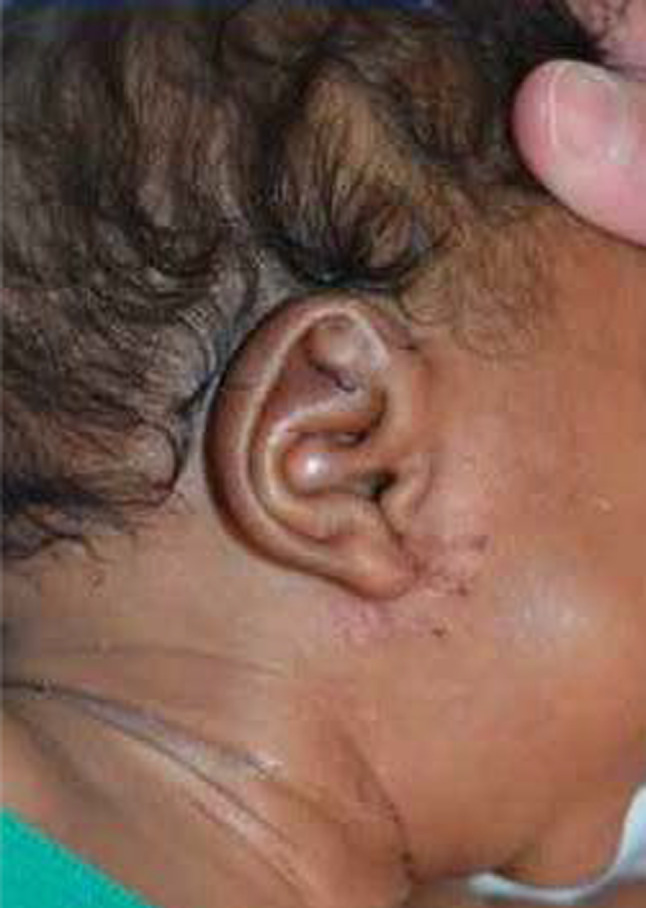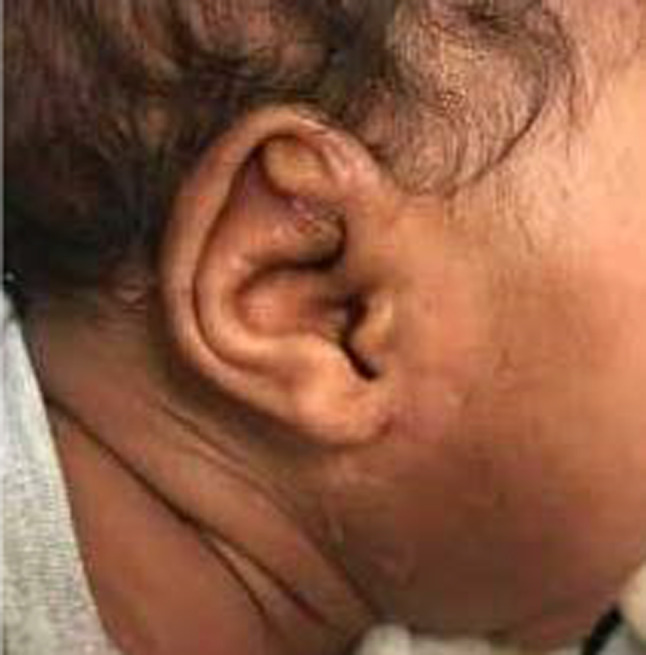Abstract
We evaluated an infant with flagrantly abusive injury. However, he had a history of prior isolated ear hematoma that was not properly recognized as a sign of trauma, harshly illustrating a missed opportunity when early diagnosis may have prevented escalating abusive injury. In addition, we reviewed and summarized the last two decades of literature related to this topic to better understand previously described findings in similar populations; these were scant. This case report emphasizes the importance of detecting sentinel injuries that forebode child maltreatment.
Keywords: Child maltreatment, physical abuse, child abuse, physical violence
Case Report
A 5 month old male infant presented to the emergency room with chief complaint of decreased right arm movement for the past three days. His primary caregiver denied any injury events. Past medical history was remarkable for severe eczema and “self-injurious behavior” for which he had been referred to Genetics by his primary pediatrician. There was no family history of coagulopathy. Physical exam demonstrated scattered abrasions to the bilateral ears, neck, upper extremities, abdomen, back, and lower extremities. His superior labial frenulum was torn. A patterned, three-prong lesion stood out anterior to his right ear lobe (Fig. 1), as did a firm nodule on the scapha of the right ear. The caregiver explained that a “boil” in that location had been drained in an outside hospital ER approximately 1 month prior to presentation (Fig. 1). Further, he resisted manipulation of his right arm.
Fig. 1.

A patterned abrasion and scaphal nodule on the right ear of a 5-month-old infant
Unexplained, prolonged and limited movement of the baby’s arm, as well as his constellation of other skin and oral injuries prompted an evaluation for abusive injury. A skeletal survey detected multiple fractures: an acute, displaced, mid-diaphyseal fracture of the right humerus; healing fractures of the left 6th–11th ribs; and healing fractures of the right 6th–8th and 10th posterior ribs. The Child Abuse Pediatrics team concurred with the diagnosis of physical abuse and referred the family to Child Protective Services. Ultimately, he was discharged to foster care.
The baby’s skin had cleared dramatically at the two week follow-up with the Child Abuse Pediatrics team, and his foster mother denied witnessing any self-injurious behavior, though the patient’s ear nodule persisted. (Fig. 2).
Fig. 2.

Persistent ear nodule and resolution of conchal bowl swelling upon 2-week follow-up
Comparison of follow-up images with photos from the patient’s admission revealed swelling of the conchal bowl which was not appreciated on his initial exam amongst his many other injuries. (Fig. 2) Records from the earlier ER procedure documented the diagnosis of an ear abscess. Procedure notes of its incision and drainage described frankly bloody fluid without organisms grown in culture, confirming the hypothesis that his previous presentation represented a traumatic hematoma. Thus, this infant suffered at least two auricular hematomas, leading to the development of permanent cosmetic deformity–cauliflower ear. (Fig. 3).
Fig. 3.

Permanent right ear deformity at 6-month follow-up
Discussion
The external ear’s position prominent location on the side of the head makes it particularly susceptible to trauma. The anatomy of the anterior ear makes it uniquely vulnerable to the development of cauliflower deformity because it lacks a subcutaneous adipose layer, so the skin is instead densely adherent to the underlying perichondrium [1]. As a result, shearing or compression forces applied to the ear result in accumulation of blood in the subperichondrial space rather than in the (nonexistent) subcutaneous fat [2–4]. Because blood supply to the cartilage is dependent on the perichondrium, hematoma formation in the subperichondrial space acts as a mechanical barrier to perfusion to the underlying cartilage. When left untreated, this lack of perfusion results in cartilage infection and necrosis. Over time, disorganized neocartilage formation and fibrocartilage overgrowth ultimately leads to the condition known as “cauliflower ear” [5, 6].
Thus, treatment of auricular hematomas should always involve drainage and placement of a pressure dressing to prevent blood reaccumulating in the dead space, preferably by a specialist in otorhinolaryngology. All auricular hematomas should be drained as soon as possible after injury. Hematomas greater than seven days old may have already begun to organize and form granulation tissue, so they warrant referral to a subspecialist in otolaryngology or plastic surgery [6]. Additionally, blunt ear trauma may occur in conjunction with TM perforation and occasionally, temporal bone fracture, so an evaluation for a hematoma of the external ear should always include otoscopy, consideration for audiometry, and possible head imaging.
The differential diagnosis for acute auricular swelling is limited, but includes trauma, infection, angioedema, and rarely, spontaneous hematomas; however, trauma is by far the leading cause. A recent prospective study evaluating 111 children presenting to an emergency department with presumed accidental ear injuries showed that infants aged less than one year rarely present with accidental ear injuries. Even rarer are bilateral accidental ear injuries [7]. Though head and neck injuries are frequently described amongst abused children, cauliflower ear is an infrequent finding in pediatric patients and few cases have been reported in the literature [2, 8]. Thus in pediatric patients, external ear injuries should always prompt consideration for physical abuse, especially in the absence of a clear history of trauma. When added to pattern injuries, such as the putative fork burn to this baby’s face, as well as his oral and skeletal findings, this baby’s case was flagrantly demonstrative of physical abuse [9]. However, clinicians may overlook signs of physical abuse when the findings are less blatant [10–12]. A missed abusive injury represents a lost opportunity to intervene for a child’s safety and well-being, and could open the door to repeated, escalating injury [13, 14]. In particular, bruising on a non-mobile infant, as well as bruising to the torso, ears or neck of any child less than 4 years of age should be viewed as a potential red flag for child abuse [15–17].
The most important factor in the detection and protection of the abused child is the awareness that such injuries do occur [18]. When concerns for child abuse arise, healthcare professionals should consult with child protection specialists and their local community partner child protection agencies to prevent the repetition and/or escalation of maltreatment.
Funding
This research did not receive any specific grant from funding agencies in the public, commercial, or not-for-profit sectors. Dr. Donaruma-Kwoh previously has provided time in expert witness consultation in the field of child abuse pediatrics for a fee.
Footnotes
Publisher's Note
Springer Nature remains neutral with regard to jurisdictional claims in published maps and institutional affiliations.
References
- 1.Pandya NJ. Experimental production of “cauliflower ear” in rabbits. Plast Reconstr Surg. 1973;52:534–537. doi: 10.1097/00006534-197311000-00010. [DOI] [PubMed] [Google Scholar]
- 2.Cuesta L, Betlloch I, Banuls J, Toledo F. Cauliflower Ear in a Teenager: A Possible Sign of Child Abuse. Pediatr Dermatol. 2012;29(2):226–227. doi: 10.1111/j.1525-1470.2011.01416.x. [DOI] [PubMed] [Google Scholar]
- 3.Singh LK, Mamidipalli SS, Das S, Tikka SK, Arora R. Cauliflower ear in late onset psychosis. Asian J Psychiatr. 2019;39:6–7. doi: 10.1016/j.ajp.2018.10.025. [DOI] [PubMed] [Google Scholar]
- 4.Teschner M, Maser F, Lenarz T. Wearing of motorcycle helmets and occurrence of auricular hematomas: a connection? HNO. 2012;60(4):343–347. doi: 10.1007/s00106-011-2417-6. [DOI] [PubMed] [Google Scholar]
- 5.Greywoode J, Pribitkin E, Krein H. Management of Auricular Hematoma and the Cauliflower Ear. Facial Plast Surg. 2010;26:451–455. doi: 10.1055/s-0030-1267719. [DOI] [PubMed] [Google Scholar]
- 6.Roy S, Smith L. A novel technique for treating auricular hematomas in mixed martial artists (ultimate fighters) Am J Otolaryngol. 2010;31:21–24. doi: 10.1016/j.amjoto.2008.09.005. [DOI] [PubMed] [Google Scholar]
- 7.Steele D, Brennan P. A prospective survey of patients with presumed accidental ear injury presenting to a paediatric accident and emergency department. Emerg Med J. 2002;19:226–228. doi: 10.1136/emj.19.3.226. [DOI] [PMC free article] [PubMed] [Google Scholar]
- 8.Rees P, Al-Hussaini A, Maguire S. Child abuse and fabricated or induced illness in the ENT setting: a systematic review. Clin Otolaryngol. 2017;42:783–804. doi: 10.1111/coa.12668. [DOI] [PubMed] [Google Scholar]
- 9.Sarkar R, Ozanne-Smith J, Bassed R. Systematic review of the patterns of orofacial injuries in physically abused children and adolescents. Trauma Violence Abuse. 2021;22(1):136–146. doi: 10.1177/1524838019827617. [DOI] [PubMed] [Google Scholar]
- 10.Jenny C, Hymel KP, Ritzen A, et al. Analysis of missed cases of abusive head trauma. JAMA. 1999;281(7):621–626. doi: 10.1001/jama.281.7.621. [DOI] [PubMed] [Google Scholar]
- 11.Kunen S, Hume P, Perret JN, et al. Underdiagnosis of child abuse in emergency departments. Acad Emerg Med. 2003;10(5):546a. doi: 10.1197/aemj.10.5.546-a. [DOI] [Google Scholar]
- 12.Cairns AM, Mok JY, Welbury RR. Injuries to the head, face, mouth and neck in physically abused children in a community setting. Int J Pediatr Dent. 2005;15(5):310–318. doi: 10.1111/j.1365-263X.2005.00661.x. [DOI] [PubMed] [Google Scholar]
- 13.Petska HW, Sheets LK, Knox BL. Facial bruising as a precursor to abusive head trauma. Clin Pediatr. 2013;52(1):86–88. doi: 10.1177/0009922812441675. [DOI] [PubMed] [Google Scholar]
- 14.Sheets LK, Leach ME, Koszewski IJ, Lessmeier AM, Nugent M, Simpson P. Sentinel injuries in infants evaluated for child physical abuse. Pediatrics. 2013;131(4):701–707. doi: 10.1542/peds.2012-2780. [DOI] [PubMed] [Google Scholar]
- 15.Harper NS, Feldman KW, Sugar NF, Anderst JD, Lindberg DM, Investigators ESTRA. Additional injuries in young infants with concern for abuse and apparently isolated bruises. J Pediatr. 2014;165(2):383–388. doi: 10.1016/j.jpeds.2014.04.004. [DOI] [PubMed] [Google Scholar]
- 16.Pierce MC, Kaczor K, Aldridge S, O'Flynn J, Lorenz DJ. Bruising characteristics discriminating physical child abuse from accidental trauma. Pediatrics. 2010;125(1):67–74. doi: 10.1542/peds.2008-3632. [DOI] [PubMed] [Google Scholar]
- 17.Sugar NF, Taylor JA, Feldman KW. Bruises in infants and toddlers: those who don't cruise rarely bruise. Arch Pediatr Adolesc Med. 1999;153(4):399–403. doi: 10.1001/archpedi.153.4.399. [DOI] [PubMed] [Google Scholar]
- 18.Grace A, Grace S. Child abuse within the ear, nose, and throat. J Otolaryngol. 1987;16(2):108–111. [PubMed] [Google Scholar]


